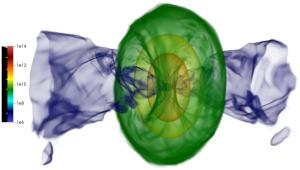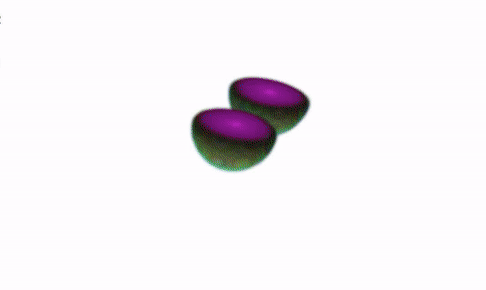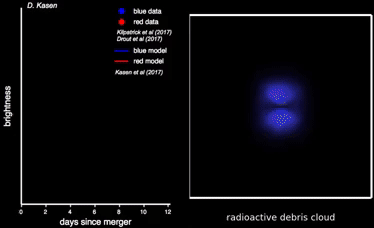New NSF Physics Frontier Center Will Focus on Neutron Star Modeling in ‘Gravitational Wave Era’
UC Berkeley-based center will bring together researchers from 13 institutions and will tap Berkeley Lab expertise
A new Physics Frontier Center at UC Berkeley, supported by the National Science Foundation, expands the reach and depth of existing capabilities on campus and at neighboring Lawrence Berkeley National Laboratory (Berkeley Lab) in modeling one of the most violent events in the universe: the merger of neutron stars and its explosive aftermath.

This rendering shows the density of matter in the aftermath of two merged neutron stars, resulting in the formation of a black hole.
The Network for Neutrinos, Nuclear Astrophysics, and Symmetries (N3AS) Physics Frontier Center is led by Wick Haxton, a theoretical nuclear physicist in Berkeley Lab’s Nuclear Science Division, astrophysicist, and UC Berkeley physics professor.

Simulation of the expanding debris from a supernova explosion (shown in red) running over and shredding a nearby star (shown in blue).
The center builds upon an NSF-funded research hub in multi-messenger nuclear astrophysics that was established in 2017, and a foundation of support for this field of research by the Office of Nuclear Physics within the U.S. Department of Energy’s Office of Science. In multi-messenger astronomy, researchers gather up data from a range of observatories to address longstanding questions in the field.

This animation shows the simulated merger of two neutron stars.
Center builds upon foundation of existing hub

An animation showing a cutaway view of the merger of two neutron stars.
The center, formally approved Aug. 10, will launch Sept. 1, 2020 – overlapping the hub, which is entering its fifth and final year.

KAGRA’s “X arm,” at left, is a vacuum pipe that measures about 2.5 feet in diameter and almost 2 miles long. KAGRA, in Japan, is teamed with gravitational wave observatories in the U.S. and Europe.
“The newly established Network for Neutrinos, Nuclear Astrophysics, and Symmetries Physics Frontier Center will reveal new information about the physics in extreme astrophysical environments, allowing scientists to address major questions in physics and multi-messenger astrophysics,” said Jean Cottam Allen, the NSF program officer overseeing the Physics Frontier Centers.

This animation (right) shows a rendering of the visible light and infrared emissions from a kilonova associated with the merger of two neutron stars. The calculations were performed using computing resources at Berkeley Lab’s NERSC. At left is a graph showing the brightness of these emissions over time.
Natalie Roe, Berkeley Lab associate laboratory director for the Physical Sciences Area, said, “In this new era of gravitational wave detection, this NSF center is well-positioned to connect the dots between some extremely interesting scientific questions, including the properties of neutron star mergers, the nature of neutrinos and dark matter, and the formation of heavy elements.”
She added, “The interdisciplinary nature of these questions makes Berkeley the perfect location for N3AS, where it can draw on expertise from both Berkeley Lab and UC Berkeley in particle and nuclear physics, astrophysics, and advanced computing techniques and simulations.”
The existing N3AS hub, led by Haxton and centered at UC Berkeley, features co-principal investigators at several institutions, including George Fuller at UC San Diego; Gail McLaughlin at North Carolina State University; Baha Balantekin at the University of Wisconsin, Madison; and Sanjay Reddy at the University of Washington.
The new Physics Frontier Center utilizes the same leadership group as its executive committee, and continues the hub’s theme: using the most extreme environments found in astrophysics – the Big Bang, supernovae, and neutron star and black hole mergers – as laboratories for testing fundamental physics under conditions beyond the reach of Earth-based labs.
Just one month after the hub’s inception, Haxton noted, there was the fortuitous first observation of gravitational waves – signatures of the warping of space-time – from the merger of neutron stars. Afterward, observatories around the world captured a series of infrared, X-ray, gamma-ray, and visible light images of the merger’s kilonova: the hot, radioactive debris produced in the merger.
These observations confirmed that elements heavier than iron were being manufactured and ejected by the kilonova. It was the long-sought first evidence for how the universe is seeded with heavy elements, known as the r-process.
The observations tracked closely with predictions by members of the research hub, including Daniel Kasen, a faculty scientist in the Nuclear Science Division’s Nuclear Theory Program at Berkeley Lab and an associate professor of physics at UC Berkeley, and colleague Eliot Quataert in the UC Berkeley Astronomy Department. Both are members of the Physics Frontier Center collaboration. Kasen is also the principal investigator for an astrophysical explosions modeling effort called ExaStar that is within the U.S. Department of Energy’s Exascale Computing Project.
The nuclear astrophysics partnership between UC Berkeley’s Physics Department and the Nuclear Science Division began 10 years ago, with strong support from the Office of Nuclear Physics within DOE’s Office of Science. James Symons, then associate laboratory director of the Physical Sciences Area, helped to expand Berkeley Lab’s Nuclear Theory Group into areas such as neutrino physics and supernova modeling with the hiring of Haxton and Kasen. A growing need for high-fidelity astrophysical modeling has led N3AS researchers to use supercomputers at the National Energy Research Scientific Computing Center (NERSC), Haxton said. NERSC is a DOE Office of Science user facility.
NSF contributed $2.4 million, and the Heising-Simons Foundation $575,000, to fund the original N3AS Hub for five years. With the upgrade to a Physics Frontier Center, Haxton noted, there will now be broader community participation in the effort, and an expanded scope of research. The NSF commitment to the N3AS Center will be $10.9 million over five years.
Haxton said that in addition to UC Berkeley and Berkeley Lab involvement in the center, a total of 12 other institutions are also taking part.
Center benefits from new experiments, continuing fellows program
“We operate as a single team, combining our expertise in order to tackle the complex multi-physics problems the arise in astrophysics – problems that are beyond the capacity of a single investigator,” Haxton said, adding, “The postdoctoral fellows we hire belong to the team, and have the freedom to move among the sites, learning the physics they need to know to make progress from a variety of world experts.”
Haxton said, “N3AS is really excited about the ‘Gravitational Wave Era,’” with a growing network of ultrasensitive gravitational wave detectors. A new underground detector in Japan, called KAGRA (Kamioka Gravitational-Wave Detector), for example, began operating in February 2020. KAGRA will be teamed with existing detectors LIGO (Laser Interferometer Gravitational-Wave Observatory) in Hanford, Washington, and Livingston, Louisiana, and Virgo (Europe’s observatory) in Italy. “We can use the detectors to pinpoint new cataclysmic events in the cosmos,” he added.
The gravitational waves produced in a merger of two neutron stars provide rich information on the structure of these exotic objects, in which a mass roughly comparable to that of the sun is squeezed into a sphere with a radius of about 6 miles. How neutron stars deform during the merger reflects properties of nuclear matter at several times the density of an atom’s nucleus.
The Center will feature close ties with RIKEN, Japan’s largest research institution, and CNRS, the French National Center for Scientific Research. It will support a fellows program that hires four fellows per year to conduct research for three years – the first two years are spent at an N3AS institution of the fellow’s choosing, and the fellow must move to a different institution for the third year of research.
The fellows program, already in place via the hub, has been important for bringing researchers together as a cohesive group, Haxton noted. “They feel like they’re connected to one another,” he said. “They function as colleagues though they reside in different institutions, and that has worked out really well for us.”
The physical home for the center will be offices and meeting space on the third floor of Old LeConte Hall at UC Berkeley. “I believe the willingness of campus research administrators to remodel this area to create a physical center for N3AS helped make our proposal competitive,” Haxton said. This area is connected by a skybridge to Campbell Hall, where new N3AS theorists Quataert and Uros Seljak have their offices.
Research focus spans from ultradense nuclear matter to dark matter
The N3AS Center will focus on a number of research areas, including:
1. The description of the ultradense, neutron-rich nuclear matter found at the centers of supernovae and neutron stars.
2. Neutrinos, responsible for most of the energy and particle count in astrophysical explosions. “The neutrino physics are very exotic in these environments, as the neutrinos are trapped and entangled quantum mechanically,” Haxton said.
3. Nucleosynthesis, the creation of new elements – particularly elements heavier than iron that are not produced in the Big Bang or by the stars as they burn.
4. Dark matter, which makes up about 85 percent of the mass of the universe, has only been observed indirectly through its gravitational effects, but can influence how supernovae and neutron stars cool.
5. The use of high-performance computing to simulate mergers and supernovae. “These models are what we use to connect the microphysics we are developing – the neutrino and dense-matter physics – to astrophysical observations,” Haxton said. “If the models can make this inner space/outer space connection, these explosions become laboratories for testing our understanding of fundamental physics.”
“Now we have to carry through by making progress in the next few years, preparing the ground for a new generation of astrophysical detectors that will be coming online in the next decade,” Haxton said.
Source: Berkeley Lab
- 483 reads
Human Rights
Fostering a More Humane World: The 28th Eurasian Economic Summi

Conscience, Hope, and Action: Keys to Global Peace and Sustainability

Ringing FOWPAL’s Peace Bell for the World:Nobel Peace Prize Laureates’ Visions and Actions

Protecting the World’s Cultural Diversity for a Sustainable Future

Puppet Show I International Friendship Day 2020

